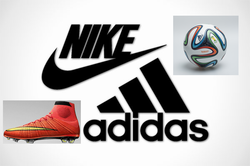
One of the reasons Adidas maintains its lead is that since 1970 it has sponsored FIFA. They have just concluded a deal up to 2030 costing them $70m for each four year cycle. This allows Adidas to put their name on the field and to produce the World Cup ball. Addidas sold 13 million of the 2010 World Cup footballs and hope to sell even more of the 2014 version.
When it comes to team sponsorship in the Brazil World Cup, Nike hold a slight advantage. Nike sponsor 10 teams including the hosts, whereas Addidas sponsor 9 teams. An interesting snippet from the documentary is when Adidas reveal that the most popular national teams shirt by sales is Columbia.
While teams are sponsored as a group of individuals, players retain the rights over what footwear they wish to place on their feet. This is illustrated by Luka Modric who carries the Nike logo on his Crotia shirt, the Addidas logo on his Real Madrid shirt, but regardless of the team he wears Nike footwear. Players like Modric promote footwear from one of limited number of lines (or silos). Heading up the silos are Ronaldo (Mercurial) and Messi (F50). Greeley and the representatives of Nike and Adidas note that the World Cup performances of Ronaldo and Messi will not fully determine the commercial success of the footwear. This is because of the range of soccer competitions in which they play and the way technology allows their performances to be seen by their fans. To illustrate the point, Greeley explains how one of the most successful soccer brands, Zlatan Ibrahimovic, is not even playing in the World Cup. It means that the battle between Nike and Addidas will continue even after the final in Brazil.
 RSS Feed
RSS Feed